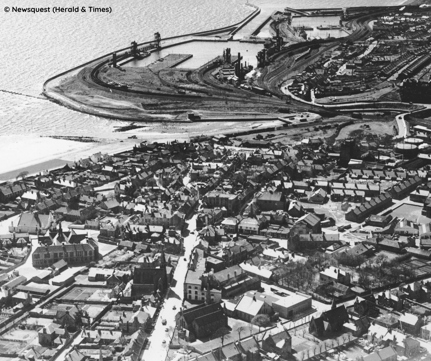 The River Leven and its surrounding communities have a rich and varied history, with activity on the river stemming back as far as the earliest settlements.
The River Leven and its surrounding communities have a rich and varied history, with activity on the river stemming back as far as the earliest settlements.
When asked what the heritage of the River Leven is, we might immediately think about its medieval castles, industrial mills or perhaps the prehistoric remains at Balfarg/Balbirnie. But, perhaps the most significant are the memories and social histories of communities along the River Leven itself. It is also important to recognise that the River Leven has itself been greatly modified through human activity, and as such, is itself a form of heritage.
There has been some debate about the origins of the name Leven but it may be from ‘Celtic’ and relate to ‘smooth- or slow-flowing river’. Changes to the River Leven, its flow, banks and flood plains, occurred particularly from the late 18th century, with the growth of industry and the use of the river as a source of energy and water for a range of purposes, such as at bleaching fields and distillery.
Such human impacts are perhaps most evident with the creation of The Cut in 1828-1830 but also through the increasing presence of mills along the River Leven Itself. This resulted in greater numbers of millponds, mill lades and weirs, the energy and sounds of the River Leven transformed: not always running smooth or slow.
The Leven Programme Heritage Framework
The Leven Programme Heritage Framework 2022-2032 provides a guiding structure for planning and delivering long term benefits for the people and environment along the River Leven through their shared heritage.
As individual projects progress, we would work with partners to consider how we might apply the framework around these, to consider and develop themes around:
- using heritage to help create a broader ‘sense of place’ and community engagement;
- capacity building through enhanced partnership working;
- broadening the role of heritage; tackling issues of social and economic deprivation;
- linking to broader developments in the area, especially relating to tourism;
- using new approaches to engage people in heritage activity.
Potential projects
Over the next 10 years, we’re also looking to embed the following heritage-inspired themes into Leven Programme projects:
Mills, materials and movement
This theme recognises that wider understanding and appreciation of the history of the mills on the River Leven and the related industries which emerged in the 18th and 19th centuries, as well as their importance to a sense of place.
We also recognise the potential to demonstrate wider relevance and connectivity, through supporting opportunities to research and learn about how the people and products relating to the mills, travelled from and to other parts of the world, such as raw materials coming from Scandinavia and the Baltics through Levenmouth.
Heritage crafts and circular economy
This theme recognises the significance of paper production (and other forms of manufacturing) in the history of the Leven.
It recognises the potential of heritage related crafts for local employability and enterprise, cutting across issues of shorter supply chains and resource security.
Future heritage Leven
This theme comprises of creative place making as a multi-generational conversation about what we leave for future generations and whether our legacy will be celebrated as Leven Heritage.
Public art was integral to the creation of Glenrothes and how it related to people who had previously lived in the area. The importance of arts and culture in developing and supporting forms of in cultural heritage will be important to explore in this theme.
Legacy
We would hope to deliver a discernible legacy at the end of 10 years of heritage-based activities and projects within the Leven Programme. These could comprise of:
- increased membership and active support of existing Heritage Groups;
- the establishment of a Leven Heritage Forum / Trust and / or other new groups interested in the Heritage of the Leven;
- wider participation in the heritage of the Leven through regular ongoing support in volunteering activities;
- better understanding and celebration of the stories of the Leven which matter to people through ongoing educational and cultural activities;
- increased numbers of visitors who spend longer in the area through using a Leven Heritage Trail running from Levenmouth to Loch Leven;
- new heritage inspired enterprises and employment opportunities.
Importantly, we see the Heritage Framework as a living document that will evolve as projects and ideas develop over the life of the project
The initial point of contact for any discussions on the application of the framework or for general enquiries on potential interaction with HES in delivery of Leven Programme activities, is Martin Ross, Development Officer in the HES Community & Economic Development Team.